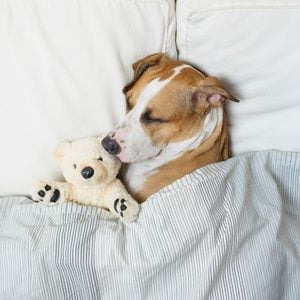Why Do Dogs Circle Before Lying Down?
Updated: Mar. 26, 2024
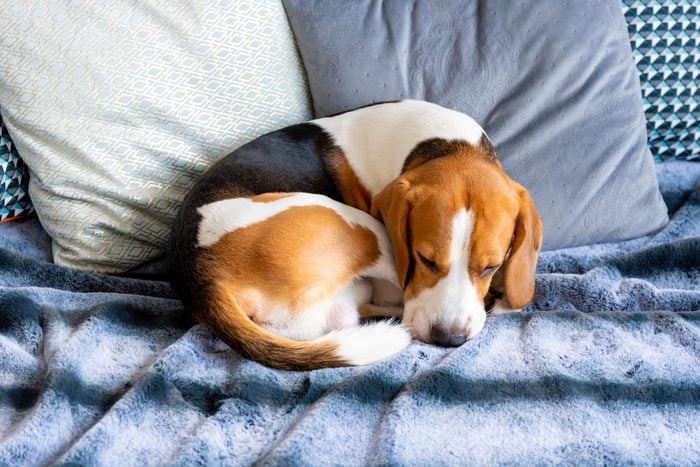
Is your pup channeling his inner wolf or simply getting comfy? To find out, we asked canine behavior experts to explain why dogs circle before lying down.
For animals that eat out of the garbage and roll around in the grass, dogs sure do love their creature comforts, especially a snugly place to sleep. From a cozy dog bed to your memory foam mattress, the softest location is often your dog’s top pick when it comes to getting some shut-eye—usually after it has twirled in an adorable little circle. But your pup isn’t the only one with that puzzling ritual. In more than 13 years as a certified professional dog trainer, I’ve heard plenty of pet owners ask, “Why do dogs circle before lying down?”
Dog behavior is a mystery to many people. And it’s no wonder! We’re two different species with different evolutionary backgrounds. You would never think of barking at the mail carrier or drinking from the toilet bowl. And you generally don’t walk in a circle before lying down to snooze. My Chihuahua, however, is a different story. He naps on a throw pillow on top of the couch, and before he lies down, he makes a “nest.” He spins in circles and paws at the cushion until his bed is just right.
This circling behavior is common in dogs, whether they’re on a blanket or in the dirt. But what exactly are they trying to accomplish, and can circling ever be a cause for concern? I talked to animal behaviorists and dog trainers and asked them pet owners’ pressing question: Why do dogs circle before lying down? Keep reading to find out what they said.
Get Reader’s Digest’s Read Up newsletter for more pet insights, humor, travel, tech and fun facts all week long.
About the experts
Reviewed for accuracy by: Wailani Sung, DVM, a vet with a board certification in veterinary behavioral medicine who owns Bay Area Vet Behavior. Dr. Sung is the co-author of From Fearful to Free: A Positive Program to Free Your Dog from Anxiety, Fears and Phobias. |
Why do dogs circle before lying down?
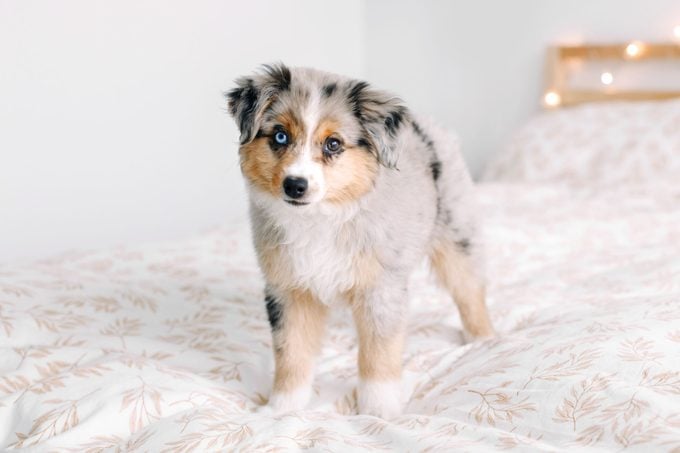
Although it’s hard to imagine your cuddly Cavapoo living in the wild, dogs share a common ancestor with gray wolves. And that ancestor defended a territory, hunted for food and slept on the ground. That heritage has left an impact on today’s pet dogs that has likely contributed to their habit of circling before they lie down.
Keep reading for the top four reasons your pup is circling before lying down.
They’re acting on instinct
Certified professional dog trainer Nicole Ellis, CPDT-KA, says there is no definitive answer as to why dogs circle. What we do know is that this isn’t a modern impulse. “It’s something dogs and wolves have been doing for a very long time,” she says.
Some experts believe a dog’s circling tendency is a genetic predisposition that stretches back to its wolf ancestors, says Mary Burch, PhD, a certified applied animal behaviorist and dog trainer. In other words, your pet’s motivations may be connected to the wolf’s reasons for circling up before bedding down.
One of those reasons could have to do with their powerful sense of smell. Ellis says some people think wolves circle before lying down to suss out the direction of the wind. Then they can arrange themselves to better sniff any intruders approaching in the night.
They’re doing a safety check
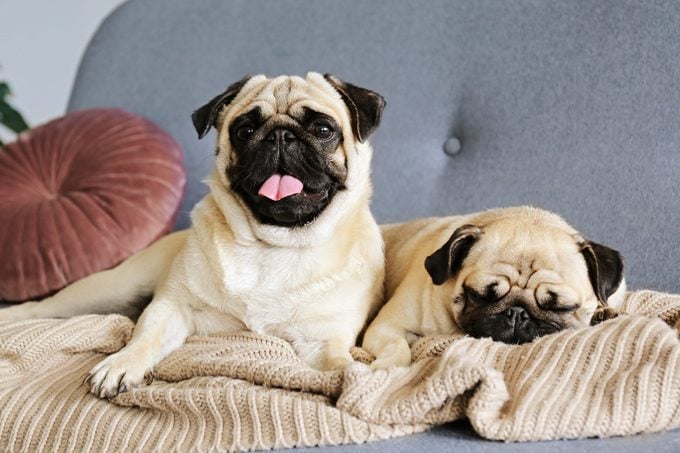
Circling before they lie down might also serve as a 360-degree safety check. Ellis says dogs’ ancestors could have circled to scan the environment and ensure their pack members were accounted for before going to sleep. Or it could have been one last look out for approaching danger.
It could have been a way to focus on nearer dangers too. Remember, the habit hearkens back to a time when plush doggy beds weren’t an option. Dirt and grass—dogs’ former sleep spaces—are very different from the environments most dogs live in today. “Some believe that their ancestors did this to stomp down tall grass and move away any snakes and insects, and it’s carried down through generations,” says Ellis.
They’re regulating their temperature
Along with circling, dogs often dig in their beds. And that may serve to help them regulate their temperature. Think about it: Digging in the dirt on a hot day will expose cooler soil underneath. And digging and circling in the snow can create a compacted nest for holding in body heat.
Burch once had a Siberian husky who loved to sleep outside in the winter, even though he was welcome inside the house. “He would turn around two to three times, as though he was patting down the snow, and lie down in a ball,” she says. “The only one who didn’t sleep well when he was outside in the snow was me—I was constantly checking to make sure he didn’t want to come inside.”
Certified behavior consultant and dog trainer Devan Amundsen, CBCC-KA, CPDT-KA, believes that modern dogs sleep curled up because the position is great at conserving heat around the core of their body. (Some of us humans even sleep curled up on our sides when we’re extra chilly!) Amundsen’s dog has a short coat with an almost bald chest and belly. “When he curls up into a little ball, it’s super obvious that his bald chest/belly gets toasty warm,” he says. “If it’s too hot out, he’ll start uncurling.”
They’re getting comfortable
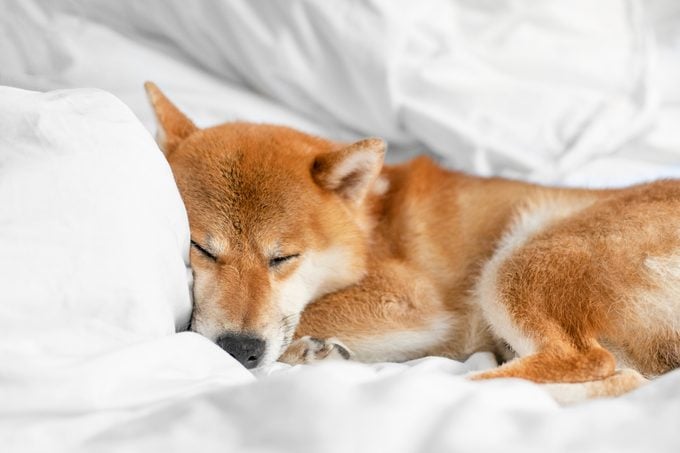
Amundsen says a reason dogs’ ancestors spun around before lying down could be as simple as getting more comfortable. “My understanding of the circling behavior is that it’s creating a relatively flat, circular spot to curl up in,” he says. “Think of how it might look if the dog was in tall grass or soft soil and did those circles. It might pat down the area, find any big uncomfortable rocks, etc.”
But what about when your dog is sleeping inside? Could comfort still be the issue? Absolutely. “With modern dogs who sleep in a cozy dog bed with padding or blankets, the dog can be circling to get the bedding just right,” Burch says. “Think of the dog who does this at bedtime as arranging the blankets and fluffing his pillows.”
When is a dog’s circling behavior a problem?
If you’re worried about your furry best friend’s over-the-top circling, take heart: Turning in circles is normal dog behavior. And it’s not limited to naptime.
Ellis notes that dogs spin in circles at other times too, such as when they are excited. Some dogs even spin around before pooping, which may be an effort to line themselves up with the Earth’s magnetic field. (A study in the Journal of Veterinary Behavior found that dogs prefer to go to the bathroom with their bodies lined up in a north-south direction.) All of that points to the fact that spinning doesn’t signify something’s wrong with your pup—but unusual or too much spinning could.
“Spinning that is excessive or out of the ordinary can be a sign of trouble that indicates the dog has a problem, such as pain [like hip dysplasia], a neurological problem or an inner ear problem [like vertigo],” says Burch.
Cognitive dysfunction in dogs may also lead to spinning, according to Ellis. This medical condition is similar to dementia in humans and can cause a dog to become disoriented and exhibit repetitive movements. Some of those movements can include head bobbing, pacing or walking repeatedly in a circle.
So how do you know when your dog’s circling behavior is cause for concern? Ellis recommends observing your pet for unusual behavior, like spinning away from the bed or having trouble walking in a straight line. Those actions would necessitate an immediate visit with your vet. Also look for signs your dog is experiencing discomfort. “If your dog is spinning for longer periods or getting up a lot after lying down and it seems it may be hard for them to get comfortable, it might be time to speak to your veterinarian and see if there is arthritis or other pain that could be affecting your pet,” she says.
FAQs
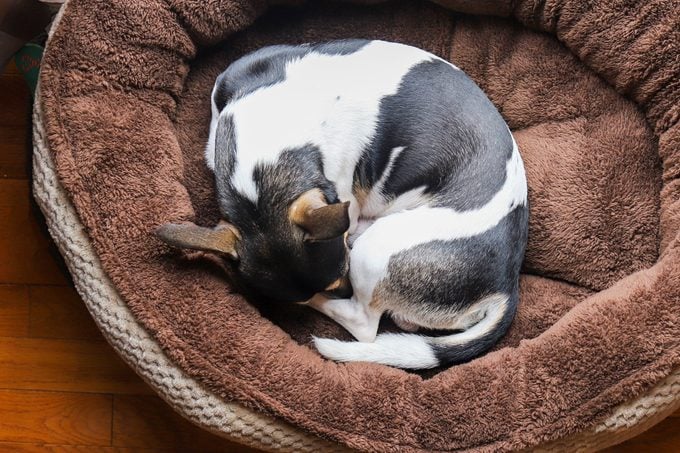
What is the fox sleeping position in dogs?
The “fox position” is a tight ball that dogs curl into before sleeping. Like circling before lying down, this common canine sleep position is also connected to dogs’ innate need for safety.
“From the early days of the ancient dog, it is thought that dogs sleep in the curled-up ‘fox position’ as a way to stay protected from animals who might be inclined to attack,” Burch says. “Sleeping in a balled-up position will ensure that an attacker can’t get to your vital organs.”
Why do dogs sleep curled up next to us?
There are a lot of reasons dogs sleep curled up next to their humans, including a desire for comfort, a sense of safety and the reminder of sleeping with their littermates when they were puppies.
Burch says dogs sleep next to us because they like us. “We give them security, and in some cases, they want to protect us,” she says. “Dogs sleep next to us as a way of being affectionate. Curling up next to one’s person can be a comfortable way for a dog to sleep—it can keep the dog warm.”
In the end, says Amundsen, it comes down to companionship. “Dogs have been by our sides for so long, both literally and metaphorically,” he says. “My own dog is curled up on his bed next to my desk right now, despite there being other bigger/softer beds available in other places in the house. Dogs are social animals. They like being around us because we’ve [selectively bred them] for exactly that for thousands of years.”
Why trust us
At Reader’s Digest, we’re committed to producing high-quality content by writers with expertise and experience in their field in consultation with relevant, qualified experts. For this piece on why dogs circle before lying down, Stephanie Gibeault, MSc, CPDT-KSA, tapped her experience as a certified professional dog trainer and journalist, and then Wailani Sung, DVM, a veterinary behaviorist who owns Bay Area Vet Behavior, gave it a rigorous review to ensure that all information is accurate and offers the best possible advice to readers. We verify all facts and data, back them with credible sourcing and revisit them over time to ensure they remain accurate and up to date. Read more about our team, our contributors and our editorial policies.
Sources:
- Devan Amundsen, CBCC-KA, CPDT-KA, certified behavior consultant, certified dog trainer and owner of Animal Welfare United; email interview, March 1, 2024
- Mary Burch, PhD, certified applied animal behaviorist, dog trainer, author of Citizen Canine and director of the American Kennel Club Family Dog program; email interview, March 11, 2024
- Nicole Ellis, CPDT-KA, celebrity dog trainer, author of Working Like a Dog and expert dog trainer on Amazon Prime’s The Pack; email interview, March 10, 2024
- Journal of Veterinary Behavior: “Directional preferences of dogs’ changes in the presence of a bar magnet: Educational experiments in Israel”




